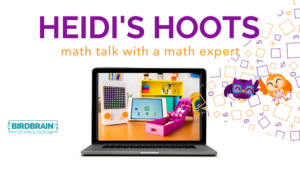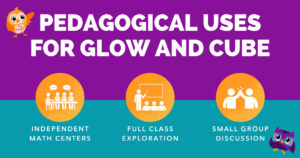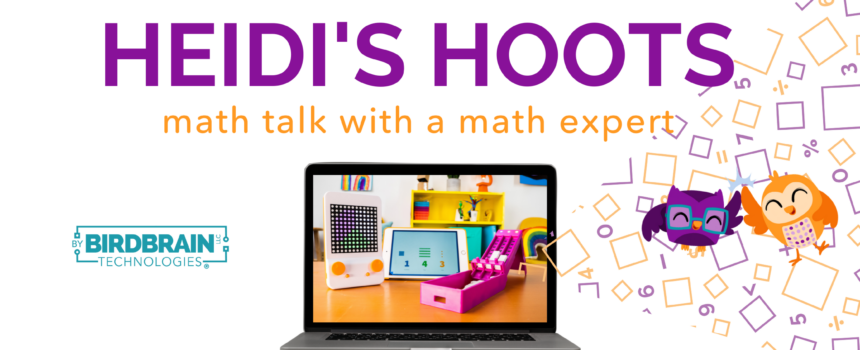 Heidi Williams is the Computer Science Curriculum Specialist for Marquette University in Milwaukee, WI. Her focus is on the K-8 integration of computer science and computational thinking within all core content areas. She is the author of ISTE’s No Fear Coding: Computational Thinking Across the K-5 Curriculum, as well as a facilitator of ISTE-U’s Computational Thinking for Every Educator course.
Heidi Williams is the Computer Science Curriculum Specialist for Marquette University in Milwaukee, WI. Her focus is on the K-8 integration of computer science and computational thinking within all core content areas. She is the author of ISTE’s No Fear Coding: Computational Thinking Across the K-5 Curriculum, as well as a facilitator of ISTE-U’s Computational Thinking for Every Educator course.
Within this Blog, Heidi will be posting on how Cube and Glow can help educators to support their students’ mathematical thinking. Over the course of the next three months, you will hear about best practices in pedagogical use, CRA – concrete, representational, abstract connections, visualization of partial products, connections to mathematical standards, and MUCH more!
Within each post you will find detailed explanations, links directly back to the components and resources of Cube and Glow, as well as external links that will provide you with more background information and support in teaching a variety of mathematical standards. As you continue to read her posts, week after week, we hope you fall in love with Cube and Glow. We also hope you enjoy the wealth of mathematical pedagogical content and strategies she shares.
Heidi has an extensive background in mathematical pedagogy, with over fifteen years of experience as a 6th – 8th grade math teacher, as well as a K-8 mathematics specialist. She has had extensive training in differentiation, coaching within a Response to Intervention (RtI) framework, as well as inquiry based instruction. Birdbrain is tapping into her understanding and passion for helping K-8 teachers with mathematical thinking in the classroom. Please join us and follow Heidi’s Hoots!

As a classroom teacher, I was always challenged with how to fit everything within a 60 minute window. Each year, planning my instructional day was always a challenge. It seemed like new things were continually being added, but nothing was really being taken out. I would sit down with my calendar…my paper calendar and pencil to try and configure my day.
My administration said we needed to provide a whole group lesson. So…some lessons need 10 minutes of explanation and others need 20 minutes…? I also had to figure out how to fit in small group instruction for children that needed extra support, a daily warm up problem of some sort, and OH YES…we also had to add in the ‘math talk’ component as well! Working harder not smarter, I used my daily warm up to engage students in ‘math talk’ ;–)
While there are many different ways to structure a 45 – 90 minute math class (depending on district requirements), most teachers engage in the pedagogical practices of whole class instruction, small group instruction, and some type of daily warm-up or ‘math talk.’ The next three blog posts will cover each one of these pedagogical practices and how Glow and/or Cube can be used within the instructional time allocated for math.
Full class exploration will cover how Cube and Glow can be used to explore concepts as you cover them. Cube will focus on teaching 1.NBT.2 – Understand that the two digits of a two-digit number represents amounts of tens and ones. Rather than just a whole class lecture/discussion/pen & paper style of lesson, adding Glow and Cube will allow students to PLAY with the concepts you are teaching.
In my own classroom, when I would send students off with manipulatives for hands-on application of skills in math centers, I often would glance over (while working with a small group) only to see students not using manipulatives with their intended purpose, looking confused as they were unsure of their work, or at times completely off task. I had many opportunities to discuss with students that throwing unifix cubes at each other did not adequately show me how they could build the number 18. Independent math centers provide students with the opportunity to apply math skills through play! Glow and Cube can provide them with real-time feedback to let them know they have successfully built the number 18.
After many years of using ‘math talk’ during warm-up problems or sometimes closing problems, I have learned that this skill is much more effective during small group discussion, as more students will have the opportunity to have their voice heard! Learn which lessons within Cube and Glow are most effective to engage students in ‘math talk.’
The next three blog posts will break down each one of the pedagogical uses for Cube and Glow:
- Full Class Exploration
- Math Centers
- Small Group Discussion
